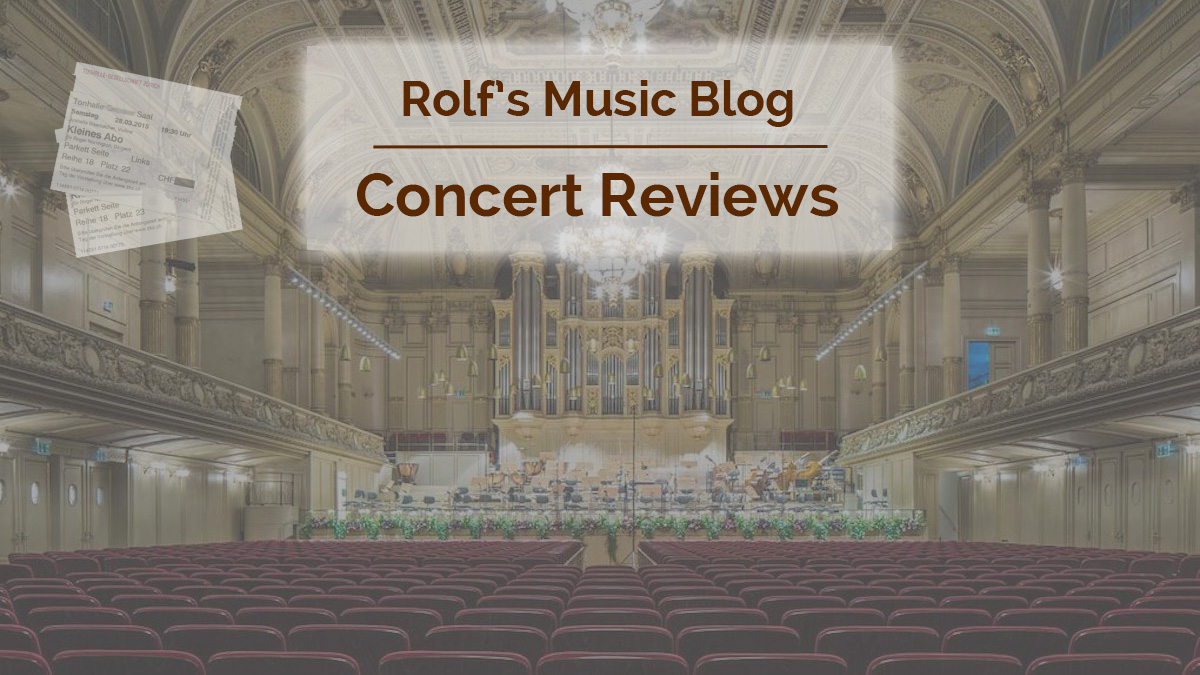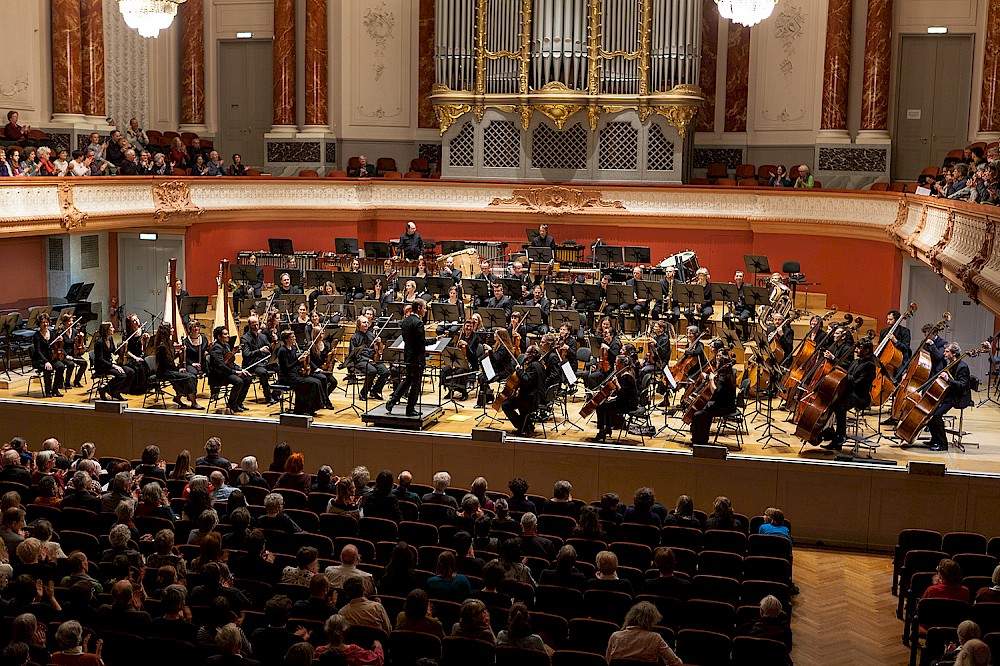Basel Sinfonietta: Epicycle 1 — Ísland
Leifs / Hjálmarsson / Þorvaldsdóttir / Vilmarsson / Bjarnason
Tonhalle Zurich, 2015-10-03

2015-10-06 — Original posting
2015-10-30 — Added YouTube videos of the entire concert
2016-08-08 — Brushed up for better readability
2018-06-26 — Removed deprecated video link
Table of Contents
- Introduction — Basel Sinfonietta
- Epicycle
- Daníel Bjarnason
- Young Icelandish Composers
- Program and Review
Introduction — Basel Sinfonietta
Different from what the diminutive “-etta” in the formation’s name would suggest, the Basel Sinfonietta is not a small ensemble. It is a full-blown orchestra with well over 100 permanent members. If needed, the ensemble size can grow to well over 200 players by adding temporary staff members. The orchestra just celebrates its 35th anniversary. One special thing about the ensemble is that it is a democratic (self-)organization. Just in this season, the orchestra has for the first time announced the election of a principal conductor, Baldur Brönnimann (*1968). He will direct the ensemble later in this season.
Over the years, the ensemble has gained recognition and acclaim not just in the Basel region, but far beyond Switzerland. It has appeared in notable festivals, such as the Salzburg and Lucerne Festivals, the International Courses for New Music in Darmstadt, and others. The orchestra is focusing on new and experimental music. And it promotes it among wider, especially younger musicians and audiences. The ensemble has worked with well-known soloists. And it has commissioned numerous compositions. Around 150 works so far have seen a Swiss or a world premiere through this formation.
Sadly, the orchestra has just been notified of planned, substantial budgetary cuts by one of the local authorities (the administration of the canton Basel-Land). These affect a wide range of cultural institutions. These cuts may not be immediately life-threatening to this institution. However, they would still have a severe impact on the work of the orchestra. It would be a major cultural loss to the area, to the cause of new classical music. And for the education of upcoming generations of young musicians. Let’s hope that some or all of this can still be averted!
Epicycle
The concerts of this season run under the title “Epicycle“. This refers to a composition by the Greek composer Jani Christou (1926 – 1970). That work is accompanying the orchestra during the entire season, along with a composition “Continuum” by the Swiss composer Lukas Huber (*1990), involving a newly developed “Infinity Machine”. Neither of these were a part of the concert program in Zurich.
The first concert in the cycle bears the title “Pony on the Rocks — Epicycle I Ísland“. It featured Icelandish compositions exclusively. Also the conductor and the pianist are both Icelandish. One remark for starting: the character “Þ” is pronounced similar to “th” in English.
Daníel Bjarnason
In this concert, the composer-conductor Daníel Bjarnason (*1979) was leading the ensemble. A conductor whose modest, even inconspicuous and calm appearance contrasted to his competence in conducting, to his in-depth knowledge of the scores. The most fascinating aspect concerning the orchestra was, how concentrated, focused, engaged and competent all of the musicians were acting. Over the entire evening there wasn’t a sign of insecurity or a single passage with bad or shaky coordination. From what I heard, the performance of the orchestra and its conductor simply left nothing to wish for. An excellent performance throughout!
Young Icelandish Composers
With the exception of the first one, the composers selected for this program are all from the same generation (born 1976 – 1987). It was amazing to hear how they all are successfully exploring territories and expressions that Continental Europeans are hardly familiar with. On the Continent, daily life (or the escape from it), interaction with humans and with living nature are (mostly) dominating music and the arts in general. In contrast, the works that we heard in this concert are describing impressions and reflections about inanimate nature. Or they deal with abstract ideas or concepts. At most with occasional cross-references to traditional European music. This unusual aspect of the program was a key component to making this concert a refreshing and impressive experience.
Program and Review
Jón Leifs: “Geysir”, op.51 (1961)
The concert started with an iconic composition “Geysir”, op.51, by Jón Leifs (1899 – 1968). Leifs is the forefather of modern “classical” Icelandish music. “Geysir” describes the course of the eruption of a geyser, starting with the early symptoms: it begins with deep sounds, played by the contrabassoon. Other instruments join in, partly with microtonal intervals, evolving into pure tones and harmonies in wave-like chords. The music then gradually builds up a monstrous scenario of Wagnerian dimension, with impressionist layers of sound.
The piece was very pictoria. But at the same time also very original, in how the composition described the grumbling, the trembling of the ground in growing waves, up to the roaring noise of the eruption. This was followed by gradual relief, calming down — not into silence, but rather into the initial, somewhat menacing situation. The pictures in this music were very striking, but never falling into triviality. Certainly very impressive!
Þráinn Hjálmarsson: “As Heard Across a Room” (2014)
The composition “As Heard Across a Room” was created last year, by Þráinn Hjálmarsson (*1987). The composer describes it as representing “how a noise-like incident is heard on the other side of a room”. In other words: it tries representing the space- and time-dependence of an acoustic event (i.e., acoustics themselves, actually), using acoustic means (i.e., music in the wider sense).
The piece starts with gently undulating noise from the entire orchestra. Indeed, the composer manages to create the impression of noises and their echo, distant sounds. Maybe not just from a the other side of the room, but like coming from another room. It felt almost like visualized acoustics, most unusual! Gradually, one hears breathy, distant melody fragments, sounds like from Aeolian harps, maybe allusions to a distant Ranz des Vaches (Kuhreihen), glissandos. Sound waves were building up, like a hilly landscape in the distance. It was never loud, rather like the breathing of a fairy, associated with breathy whistling tones. Fascinating and enchanting!
Anna S. Þorvaldsdóttir: Aerality (2011)
The piece “Aerality” by Anna S. Þorvaldsdóttir (*1977) describes the “state of gliding in the air”. A bass beat opens up a cosmos of melodic fragments. Sequences of overtones (harmonics) from wind instruments on top of a primordial swooshing noise. The continuous roaring of a giant gong, beats, both from string instruments and percussion.
At times, I believed to hear the murmuring of a large mass of people, then again something like the weaving of nature (analogous to Wagner’s “Waldweben”, the “weaving of the woods”) over archaic worms in the depth of the earth. Rather than living nature, I pictured / imagined the colors of the sky and clouds, the playing of winds with objects, the interplay of light, air, and clouds, up to the bright, lucid light after a clearing, purifying thunderstorm.
Apart from the acoustic impressions, it was most fascinating to observe the use of the orchestra’s overwhelmingly rich set of instruments. Anything that can possibly, somehow create sounds or noises seemed to be represented in the orchestra. There were carillons and a vast range of percussion instruments, up to boomwhackers. New types of sound resulted from very unusual methods, also with conventional instruments such as string instruments (violins, also the harp).
Hlynur Aðils Vilmarsson: “BD” (2014)
Hlynur Aðils Vilmarsson (*1976) completed his composition “BD” in 2014. He describes the composition as a the “intensification of pallid sound events”. Noises, motifs, clusters of sounds or chords form from archaic, primordial sounds (e.g., impulses from percussion instruments, of from the contrabassoon).
Here, we again meet the sound of winds, mixed with the sound of Aeolian and glass harps. At some point I meant to hear the bubbling of marsh gases, the forming of nature from a primordial soup. Maybe even the creation of the universe from nothing? Masses of archaic beings, shouting, whistling, sounds of aboriginal populations. On to the appearance of civilization, the sounds of a marching band. This built up to industrial sounds, menacing machine worlds. I felt almost like being transferred into Charlie Chaplin’s “Modern Times”. An overwhelming collection of soundscapes and impressions! Information on this piece is found at the ICSM site.
Daníel Bjarnason: Processions (2010)
The last composition in the program was “Processions”. This was written the conductor in this concert, Daníel Bjarnason (*1979). It is Bjarnason’s second contribution to the genre. A virtuosic piano concerto, featuring the three movements „In Medias Red“, „Spindrift“, and „Red-handed“. Soloist at the Steinway grand was Víkingur Ólafsson (*1984). An excellent artist, virtuosic, with superb technique and very differentiated key touch.
Movement 1: In Medias Red
The composition begins with a bass beat and an upwards glissando on the piano. The work starts with grand gestures, also in the rich accompaniment. Bjarnason uses the piano both as percussion instrument, as well as melodically. The solo part is often bitonal and polyrhythmic, with allusions to late and post-romantic music (Prokofiev? Bartók?). But the movement also featured more intimate moments, delicate, fragile melodic segments with accompaniment of a solo violin. But there are equally Wagnerian soundscapes, up to primordial forces and Mahler reminiscences. Then again, one detects Bach’s polyphony in the solo, unaffected by shrill interjections from the orchestra. The accompaniment also appears to allude to composers such as Górecki, or Pärt and his approach to minimal music.
Movement 2: Spindrift
To me, the second movement was a representation of absoluteness. A world of purest, utter beauty, the harmony of the spheres, dream-forlorn melodies, tremolandi in the piano. The solo part followed with an eruption of archaic forces, relaxing again, calming down to the harmony and peacefulness of the beginning, with voices almost like from heaven.
Movement 3: Red-handed
The last movement features an extremely virtuosic solo part. Starting in the piano, the music builds up tumultuous scenes. It reminded me of a march to the place of execution. In-between: a reminiscence of Ravel’s picture of a lonely gibbet (“Le gibet” from “Gaspard de la nuit”). Stormy winds in the solo, turmoil, troops marching by. A moment of baroque clarity. Then again turmoil, martial, menacing scenes in the orchestra, leading to a triumphant, rhythmically sturdy ending. To me, as an experience, it was both unheard-of and enormous!
Encore — Jean-Philippe Rameau (1683 – 1764): “Le Rappel des Oiseaux“
In response to the enthusiastic, well-deserved applause, Víkingur Ólafsson played “Le Rappel des Oiseaux“ by Jean-Philippe Rameau (1683 – 1764), the fifth movement from “Pièces de Clavessin”, Suite in E minor, RCT 2. This proved that his repertoire is not limited to contemporary music. He also “talks” the baroque language and the art of baroque ornamentation.
Conclusion
No doubt: I was totally enthused from the experience of this concert. It was a surprise (and a complete mystery) to me to see how small the audience was. In Basel, on the day before, the concert was apparently sold to around 75%. This is probably what one would expect for a concert with new music only. But here, about 75% of the seats in the Tonhalle remained empty. Was this an expression of the rivalries & mutual resentments between Basel and Zurich? All I can say is: those who decided to stay at home were missing out on a really great, fascinating concert experience!
Addendum
For the same concert, I have also written a (much shorter) review in German for Bachtrack.com. This posting is not a translation of that German review, the rights of which remain with Bachtrack. I create the German review using a subset of the notes taken during this concert. I wanted to enable my non-German speaking readers to read about my concert experience as well. Therefore, I have taken my original notes as a loose basis for this separate posting. I’m including additional material that is not present in the Bachtrack review.





